Wal-Mart Stores has cast itself as a fast-moving innovator with intentions on continued advances into the U.S. food and consumables market, including an aggressive campaign to expand fresh produce sales, the potential to accelerate grocery and club store rollouts, and an appetite for e-commerce and other means of driving growth and efficiency.
Couched carefully in messages of employee appreciation, consumer advocacy and corporate compliance — “The Real Walmart” as a new ad campaign puts it — the world’s largest retailer celebrated before 14,000 enthusiastic workers in a star-studded annual meeting event near its Bentonville, Ark., headquarters earlier this month.
Bill Simon, chief executive officer of Walmart U.S., in remarks at a press event prior to the meeting reiterated his belief that a strategy based on expense controls and price investments would continue to drive results through a virtuous productivity loop. Despite a sales blip in the first quarter of this year, which he attributed to unusual events including poor weather and an adjustment to new tax laws, he expects same-store sales to continue to rebound for a third straight year.
MORE WAL-MART COVERAGE: • Mobile Keys E-Commerce at Wal-Mart
• Mobile Keys E-Commerce at Wal-Mart
• ‘American-Made’ Makes a Comeback
• Wal-Mart’s Bright Ideas on a Global Scale• Ad Campaign Seeks to Boost Image
 • Diverse Opportunities for Walmart International
• Diverse Opportunities for Walmart International
• Wal-Mart on a Mission to Hire Veterans
• Infographic: Wal-Mart Logistics Statistics
“The strategy,” he said, “is working.”
In the U.S., Wal-Mart is supplementing its approach on the basics with efforts to expand the basket with new items and provide needs for shoppers no matter where they are on the economic spectrum. In an economy that’s seen sluggish recent improvement, Simon said the Wal-Mart shopper is adapting.
“The consumer is becoming resilient,” Simon said. “They tell us they’re figuring it out. It’s not getting much worse, but it’s not getting a lot better. What’s interesting is that we see really robust sales around certain events — Valentine’s Day, Mother’s Day — so they are spending on their family. But in the interim, they hunker down and try to figure out how to get to the next one.”
New Produce Initiative
In food, Wal-Mart is looking to make gains in fresh produce similar to the ones it made in fresh meat a year ago. This effort involves actions both behind the scenes and out in front of consumers, explained Jack Sinclair, executive vice president for grocery for Walmart U.S.
“We had a very strong year last year in our meat business, where we invested in product quality and improved the quality of our meat and did some commercials that really caught the imagination of our customer,” Sinclair said in an interview with SN. “This year we are investing in fresh produce and getting the same lift.”
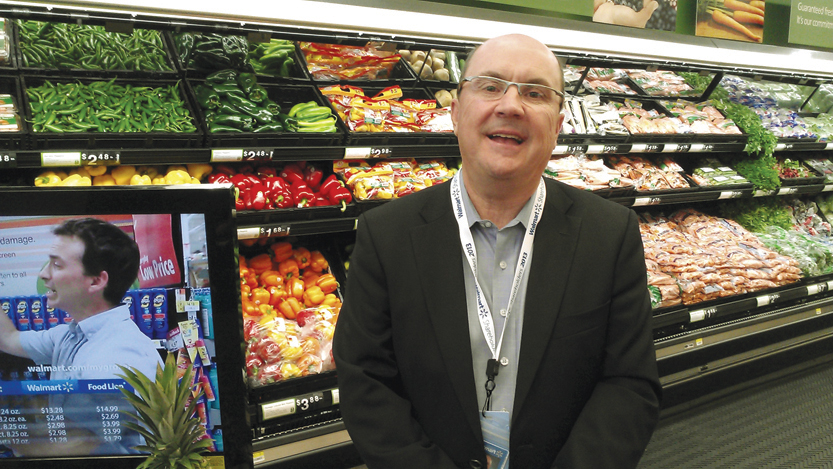
The commercials include a series of “Fresh-over” spots that broke late last month in which Wal-Mart secretly replaces the stock at a farm stand with Wal-Mart produce and films customer reactions. The commercial provides a hook for a newly launched Fresh Produce Guarantee whereby the company is offering a 100% money-back guarantee for customers who aren’t satisfied with their produce purchase.
Behind the scenes, the new produce campaign is an efficiency program built around new ways of buying and transporting produce, backed by new training programs and a secret shopper program to ensure consistency, Sinclair said.
Wal-Mart has gone to direct sourcing for around 80% of its produce and consolidated suppliers to help speed the product to market, Sinclair explained. Around 70,000 associates have been trained in proper produce handling and provided guides to help identify top produce.
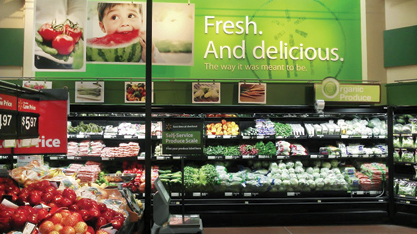
“The ultimate goal is to give the customer better quality, more freshness, at a great value. That’s what resonates,” Duncan Mac Naughton, Wal-Mart’s chief merchandising officer, added. “We think about it from farm to fork and actually put our sourcing agents in the fields. We are also consolidating the growers so we can deliver more frequently to stores so they get faster turns, we’re getting fresher product and [shoppers get] more life in the refrigerator at home. That’s the game.”
Sinclair declined to quantify the lift Wal-Mart saw in fresh meat last year but acknowledged the combination of efficient procedures, a captivating ad campaign and sampling programs helped to change shopper perceptions and sales along with it. The produce program is one of three strategic priorities in food for Wal-Mart, Sinclair said. Investing in price and localizing assortments are the others.
The price program, centered on comparison ads showing basket-price differences on identical grocery and consumable items, is running in 60 markets today and continues to be effective, Sinclair said. “Our strategy is about price and how do we make sure the differential on price is very clear to the customer every time they come in.”
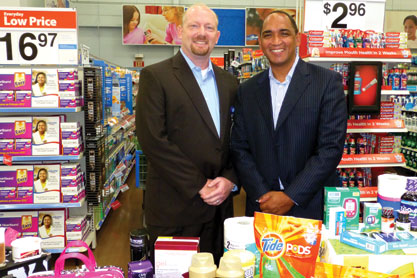
Wal-Mart is also determined to offer more appropriate assortments by region, he added. In products like ice cream, the company is offering store-specific plans for the first time this summer. “You’re going to see a lot more of that from us,” Sinclair said, adding that the company is midway through a plan begun in 2010 to double local product sourcing.
Elsewhere in the store, Wal-Mart’s merchants are focused on national brands, innovations and assortments with appeal to customers all along the economic spectrum. In categories like consumables, the broad assortment helps to defend against dollar stores at the low end and chain drug stores at the higher end, said Scott Huff, senior vice president of consumables. Innovations include newly launched categories like premium pet food and exclusive brands in cosmetics such as Powder by Drew Barrymore.
Drug and pharmacy departments take a similar approach to assortment, said John Agwunobi, senior vice president of health and wellness. As in produce, Wal-Mart is using Nielsen and company data to identify sales gaps and stock with appropriate local and regional items, Agwunobi said. A price message comes behind $4 generic prescription drugs and non-branded pharmaceuticals for 88 cents.
More Self-Checkouts
In U.S. stores, the company is committed to a new rollout of self-checkouts as part of a push to improve efficiency and convenience for shoppers, said Jeff McAllister, senior vice president of innovations. The changes included moving the self checkout to the grocery side of the store and reconfiguring eight units horizontally in a “bullpen” configuration. The new layout requires that some stores will remove a few lanes of traditional attended checkout, but also allows for merchandising around the self-check pen that wasn’t possible in the vertical arrangement, McAllister said.
The company began testing the new layout last October and is now committed to rolling it out to 1,500 more stores.
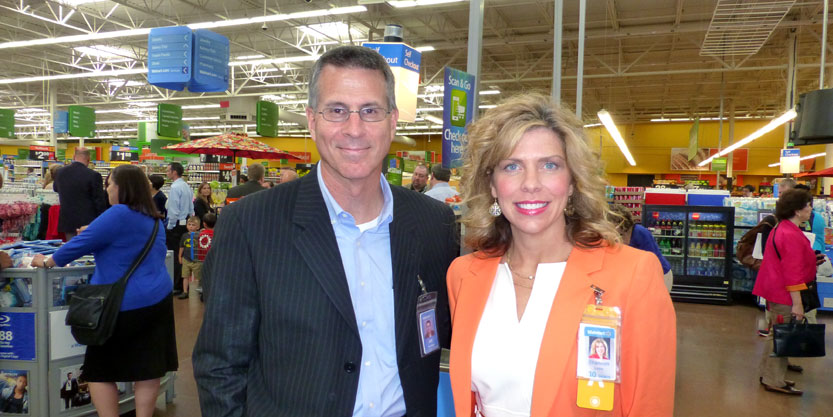
“We had [self-checkouts] many years ago but we were spotty in the ways we used the equipment; it was different equipment and at a different end of the store,” McAllister said. “What we realized was that with all the investments in technology, the customer became more used to self-service.
“We explored a lot of ideas from around the globe and also looked at our own equipment,” before deciding on a new style from NCR, he added. “We’re seeing something like 20% to 30% migration from manned lanes into the self-checkouts. That gives us the ability to take costs out of the network and reinvest it in price.”
The new checkouts also are designed to work with the nascent Scan & Go technology that’s also getting a new commitment from Wal-Mart after promising early results, officials said.
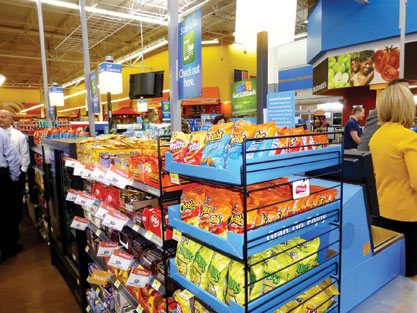
The focus on front-end efficiency is also manifesting itself in new applications of Wal-Mart’s “MyGuide” task management system. Originally started to provide overnight workers with task messages, some stores began to use it to assign cashiers to stands. Pleased with the potential it held to speed checkout times and reduce inefficiency, MyGuide is now being used in all U.S. stores for that task.
Prior to MyGuide, cashiers’ lane assignments were given to them by their supervisors, said Shannon Letts, vice president, multichannel and merchant innovations. “They would walk in and find their customer service manager for a lane assignment,” Letts told SN. “But that manager might have been getting change for a register, or helping a customer, so the cashier would stand around waiting.
“Now it allows the cashier to check in from the MyGuide hubs on the sales floor and get their register assignment so they can go directly to their assigned station and start checking customers out.”
The process may save only seconds but at Wal-Mart’s size and scale, such little things add up. Gisel Ruiz, executive vice president and chief operating officer, mentioned that if Wal-Mart could fit one more item into every shopping bag, it would represent annual savings of $100 million.
Format Evolution
Simon said Wal-Mart was continuing to test its Express stores, particularly with an eye toward stocking them most efficiently, before a wider rollout. The stores — which carry a mix of general merchandise, food and pharmacy in a 12,000-square-foot box — are performing well from a sales standpoint, he noted.
“We’re in the process of building them out in density so we can improve on the supply chain end if it. Comp sales are really good, 16%, so we’re really pleased with the top line on them. But we really want to get them to a point where we can replicate them in large numbers, and when we do we’re going to go.”
Down the road, Wal-Mart envisions Express stores — along with the larger Neighborhood Market format — integrating with e-commerce as a seller and distribution point.

“Put a small store in the ground but connect it to our logistics and e-commerce structure and make it feel and operate financially like a much bigger store,” Simon said. “When we can do that, we will be able to tap markets and geographies that we haven’t been able to yet because of financial constraints.”
Neil Ashe, president of Wal-Mart’s global e-commerce business, said stores could also be used as the “last node” in an e-commerce delivery network, providing “a very uniquely Wal-Mart solution to this problem.”
Wal-Mart has plans to open between 80 and 100 new Neighborhood Market stores this year and next, but Simon said the company could accelerate that rollout pace, citing an effective performance and returns approaching those of the Supercenter format.
While declining to disclose specific sales figures, Simon said the Neighborhood Market stores were “comping as well as any grocery chain in U.S.,” citing a hybrid format that competes effectively with drug, conventional grocery, and dollar stores.
“Neighborhood Market is a really cool format,” he said. “It’s a grocery store combined with a drug store put in a place where a dollar store would be. It has performed really well from a convenience standpoint.
“Imagine a drug store that has Wal-Mart’s prices that has fresh food, fresh produce and fresh meat. Imagine a convenience store that has pharmacy and fresh food. Imagine a grocery store that also has a pharmacy and, in many cases, gas, and the prices Wal-Mart has. It just really works well against any competitive set it operates against.”

The company will likely confine Supercenter openings to existing markets and has stopped pushing for a site in places like New York City.
“Our strategy has now shifted a bit. It’s easier and faster and more profitable for us to take a market where we have a 10% share and turn it into a 15% share than it is for trying to move a 1% share to a 2% or 3% share,” he said. “We’re focusing on opportunities where we see our brand is already well-accepted by the customer and the community — places that ask for us. We’re putting stores there.”
Wal-Mart’s Sam’s Club division is also accelerating new store growth, Rosalind Brewer, Sam’s Club’s CEO, said. After several years of building around three new stores per year, Sam’s opened nine stores last year and has plans for as many as 20 this year. This rate reflects strong comp-store growth among members despite struggles among small business members, Brewer said.
Ironically, many of their troubles can be traced to rapid retail store growth, she said. Convenience store operators have been hurt by expansion of chain dollar stores and their subsequent addition of tobacco products. “Mom-and-pop” restaurants in the meantime have been challenged by more effective competition from quick-service restaurants, resulting in unprecedented price pressure, she said.
To that end, Brewer announced that Sam’s Club this summer would begin sponsoring a series of business “boot camps” to address a member base she described as “financially strapped” and uncertain about investing.
Sam’s this summer will also be rolling out Scan & Go technology, Brewer said, citing a core shopper base that’s more app-savvy than Wal-Mart’s typical shopper.
While efficiency and the benefits flowing from it was a major theme of Wal-Mart’s strategies as presented during the shareholders meeting events, the company was careful to balance that with an emphasis on its employees. This message and the accompanying “Real Walmart” campaign could be seen as a kind of passive response to its critics, several of whom had a chance to speak at the meeting itself. The speakers included a Bangladeshi labor activist, Kalpona Akter, who urged voters to adopt a policy making it easier for small stakeholders to call a meeting. Citing the tragedies at factories said to have done work for a Wal-Mart supplier, Akter said Wal-Mart’s supply chain was “out of control.”
Another speaker, sponsored by the union-friendly dissident Wal-Mart employee group OUR Walmart, drew applause from some attendees when she raised the issue of pay disparity between the company’s top executives and its hourly workers.

Their proposals — along with a third advocating the appointment of an independent director, sponsored by several hedge-fund investors — were defeated, also drawing cheers from a crowd entertained that morning by actors Tom Cruise and Hugh Jackman and musicians including Prince Royce, John Legend, Kelly Clarkson and Jennifer Hudson. And in a show of opportunity for workers, two employees were promoted live on stage.
In remarks at the show, Mike Duke, Wal-Mart’s president and CEO, praised workers for their role in the company’s success.
“Our long-term strategies are working,” Duke said. “Our expense management is driving EDLP and EDLC. We’ve leveraged expenses as a company for the last three years and we’re committed to making it four in a row. And the investments we’ve made in e-commerce are really paying off.
“None of this would be possible without the heart and hard work of our associates,” he continued. “You are the reason Wal-Mart is strong and getting stronger around the world.”
| Suggested Categories | More from Supermarketnews |

|
|

|
|


